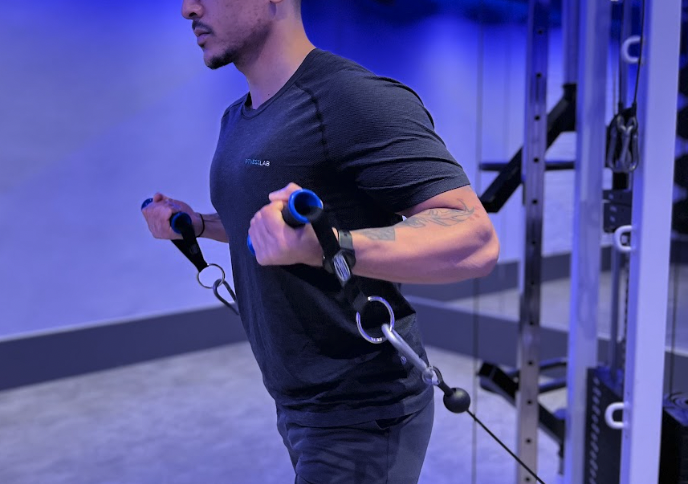Muscle hypertrophy is the process by which our muscles grow physically larger, and it occurs when we engage in strategic, consistent, and harder workouts.
Understanding what it means and, more importantly, how to achieve it is not just about aesthetics. Larger muscles are associated with stronger joints and ligaments, increased bone density, and longer, more functional life spans.
What is hypertrophy?
In biology, hypertrophy is the process of cells or tissues growing. Likewise, muscle hypertrophy refers to the increase in the size of the muscles.

By causing mechanical stress and small muscle tears/damage through resistance training, muscle growth can be generated.
However, how much and how quickly this happens is influenced by many other factors like the type of training done, hormones, nutrition, sleep and recovery.
Types of hypertrophy
There are two types of muscle hypertrophy: myofibrillar and sarcoplasmic.
To put it in simple terms, there are two elements of the muscle cell that are able to grow and develop.
One is the fluid (cell’s sarcoplasm) and that is associated with an increase in volume without necessarily an increase in strength.
The second one is the contractile part of the cell – the part containing those elements of the muscle cells that allow it to contract and relax – the myofibrils. Myofibrillar hypertrophy comes with an increase of strength and minimal increase in cell volume.
Although these two types/concepts may seem too advanced for a typical gym-goer, it is important to know about them in order to understand why you should perform a particular number of reps and not another. As different rep ranges drive different adaptations, some people may adapt their training to target either muscle size with rep ranges from 6 to 15 or muscle strength with rep ranges like 1-5 per set.
Training for hypertrophy vs training for strength
In order to understand the differences between training for hypertrophy and training for strength, we must first understand the similarities.

Strength and hypertrophy training share many exercises and use similar equipment, but their techniques differ based on the desired outcome.
Although they have separate names and goals, they are not mutually exclusive. Growing muscles requires your body to adapt to a new stimulus every time (heavier weights, more reps and sets, etc) which, over time, will bring some strength adaptations, too. In other words, you will get bigger muscles but also stronger muscles even without aiming for both.
Likewise, aiming for strength gains will help your muscles grow over time (may not be the most efficient way to achieve a big bulky physique but it will grow some muscles, especially at the beginning). An ideal program for strength training will include some hypertrophy work for the simple reason that larger muscles can deal with heavier loads more easily.
Hypertrophy Training
Bodybuilders and trainees aiming to build the muscles in a particular area/region more than others are commonly known to use hypertrophy training. It is a common way of training for those looking to “tone up” too because toning is nothing else but a combination of bigger muscles and lower body fat.
To increase the size of your muscle tissue as much as possible, more sets, and low to intermediate repetition ranges will be performed, with shorter rest periods of time (1-2 minutes) and . Furthermore, hypertrophy training involves more isolated exercises ( targeting one muscle at a time) like leg extensions, biceps curls, hamstring curls, etc.
Strength training
Strength training, as its name suggests, is designed to increase your strength or the force your muscles can exert. Strength training differs from hypertrophy workouts that are aimed primarily at building muscle mass, since it focuses on improving the body’s ability to pull, push, lift, hinge, squat, among other movements – all compounds.
For example, one of the most popular strength training exercises is bench press, as it works almost every muscle in your upper body, including your chest, deltoids, triceps, forearms, and more.
What might a hypertrophy workout look like?

Take a look at a sample hypertrophy training for chest, shoulders and triceps:
Barbell Chest Press – 3 sets, 12 reps, 70% 1 RM
Incline DB Chest Press – 3 sets, 6-12 reps, 70% 1 RM
Shoulder Press – 3 sets, 6-12 reps, 70% 1 RM
Triceps Cable Extension – 3 sets, 6-12 reps 70% 1 RM
Bent Over Single Arm Cable Triceps Extensions – 3 sets, 15 reps ES
Got any questions about training for hypertrophy? Feel free to contact us!

